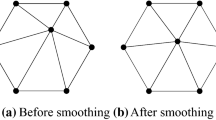Abstract
Mesh smoothing is an essential technique for the improvement of mesh quality in finite element analysis, due to the fact that mesh quality has a large impact on the convergence of the computational scheme and the accuracy of the numerical results. A novel mesh smoothing method based on regular-position-guided operations is presented in this paper. The method introduced here contains two main stages: The first stage computes the regular position of each vertex based on the shape of the element and conducts regular-position-oriented-based element transformations independently; the second stage determines the finial position of each vertex according to its surrounding elements with an assembly strategy. This method is not limited to planar triangular mesh, but applicable to surface polygonal mesh. Numerical experiments on various mesh models demonstrate the effectiveness and potential of this method.








Similar content being viewed by others
References
Basaran C. Solving large-scale problems in mechanics: the development and application of computational solution methods. Int J Numer Anal Methods Geomech. 1994;18(2):139–40.
Plassmann LAFP. Local optimization-based simplicial mesh untangling and improvement. Int J Numer Methods Eng. 2000.
Freitag L, Leurent T, Knupp P. MESQUITE design : issues in the development of a mesh quality improvement toolkit; 2002.
Durand R, Pantoja-Rosero BG, Oliveira V. A general mesh smoothing method for finite elements. Finite Elem. Anal. Des. 2019;158:17–30.
Vartziotis D, Wipper J. The geometric element transformation method for mixed mesh smoothing. Eng. Comput. 2009;25(3):287–301.
Sun S, Zhang M, Gou Z. Smoothing algorithm for planar and surface mesh based on element geometric deformation. Math. Probl. Eng. 2015;2015:1–9.
Field DA. Laplacian smoothing and Delaunay triangulations. Commun. Appl. Numer. Methods. 1988;4(6):709–12.
Ji Z, Liu L, Wang G. A global Laplacian smoothing approach with feature preservation. In: IEEE 9th international conference on computer aided design and computer graphics; 2005.
Zhihong M, Lizhuang M, Mingxi Z, Zhong L. A modified Laplacian smoothing approach with mesh saliency. In: Smart graphics, 6th international symposium, SG 2006, Vancouver, Canada, July 23–25, Proceeding, 2006.
Vollmer J, Mencl R, Muller H. Improved Laplacian smoothing of noisy surface meshes. Comput Graph Forum. 1999;18(3):131–8.
Xu H, Newman TS. An angle-based optimization approach for 2D finite element mesh smoothing. Finite Elem Anal Des. 2006;42(13):1150–64.
Vartziotis D, et al. Mesh smoothing using the geometric element transformation method. Comput Methods Appl Mech Eng. 2008;197(45–48):3760–7.
Sun S, Gou Z, Geng M. Simultaneous smoothing and untangling of 2D meshes based on explicit element geometric transformation and element stitching. Appl Sci. 2020. 10(14).
Frey PJ, Borouchaki H. Geometric surface mesh optimization. Comput Vis Sci. 1998;1(3):113–21.
Wang D, et al. Enhanced remeshing from STL files with applications to surface grid generation. Commun Numer Methods Eng. 2006;23(3):227–39.
Huang Y, Qin H, Wang D. Centroidal Voronoi tessellation-based finite element superconvergence. Int J Numer Methods Eng. 2008;76(12):1819–39.
Ahmed AGM, et al. A simple push-pull algorithm for blue-noise sampling. IEEE Trans Vis Comput Graph. 2017;23(12):2496–508.
Chen L. Mesh smoothing schemes based on optimal Delaunay triangulations. In: Proceedings of the 13th international meshing roundtable, pp. 109–120, Sandia National Laboratories, 2004.
Liu J, Li S, Chen Y. A fast and practical method to pack spheres for mesh generation. Acta Mech Sin. 2008;24(4):439–47.
Shimada K, Gossard DC. Bubble mesh: automated triangular meshing of non-manifold geometry by sphere packing. In: Proceedings. Third symposium on solid modeling and applications, 1995; 409–419.
Yagou H, Ohtake Y, Belyaev A. Mesh smoothing via mean and median filtering applied to face normals. In: IEEE proceedings of the geometric modeling and processing, 2002.
Knupp PM. Algebraic mesh quality metrics. SIAM J Sci Comput. 23(1), 193–218.
Lo DSH. Finite element mesh generation. Boca Raton: CRC Press; 2015.
University RA. OpenMesh. http://www.openmesh.org/.
Author information
Authors and Affiliations
Corresponding author
Rights and permissions
About this article
Cite this article
Hai, Y., Guo, Y., Cheng, S. et al. Regular Position-Oriented Method for Mesh Smoothing. Acta Mech. Solida Sin. 34, 437–448 (2021). https://doi.org/10.1007/s10338-020-00201-z
Received:
Revised:
Accepted:
Published:
Issue Date:
DOI: https://doi.org/10.1007/s10338-020-00201-z




